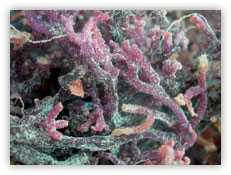
Product and Raw Material Information
 Carrageenans are large, highly flexible molecules which curl forming helical structures. This gives them the ability to form a variety of different gels at room temperature. They are widely used in the food and other industries as thickening and stabilizing agents. A particular advantage is that they are thixotropic-they thin under shear stress and recover their viscosity once the stress is removed. This means that they are easy to pump but stiffen again afterwards.
Carrageenans are large, highly flexible molecules which curl forming helical structures. This gives them the ability to form a variety of different gels at room temperature. They are widely used in the food and other industries as thickening and stabilizing agents. A particular advantage is that they are thixotropic-they thin under shear stress and recover their viscosity once the stress is removed. This means that they are easy to pump but stiffen again afterwards.
Carrageenan is made up of sodium, potassium, magnesium and calcium sulfate esters of galactose and 3,6-anhydrogalactose units. It is a natural ingredient obtained from certain species of the red seaweed, class Rhodophyceae. Popular sources for carrageenan are the Chondrus Crispus, Eucheuma Cottonii and Eucheuma Spinosum species.
The Chondrus Crispus speciegrows mainly in cold water territories such as the northern coasts of the Atlantic while the Eucheuma species are abundantly found in temperate climates like the Philippines. The Philippines has successfully launched and maintained numerous Eucheuma Cottonii and Eucheuma Spinosum seaweed farms providing ample supply and good quality to meet the growing demand. Mostly, the Eucheuma Cottonii is usedfor kappa carrageenan and the Eucheuma Spinosum for iota carrageenan.
Today, carrageenan, a natural hydrocolloid, is a powder extracted from various species of red algae that are farmed and processed. There are three fractions of carrageenan: kappa, iota, and lambda. Kappa carrageenan is used when a firm, rigid gel is desired. Iota carrageenan forms elastic and water retentive gels. Lambda carrageenan, on the other hand, has no gelling properties, but can produce the highest water viscosities among all the other carrageenan fractions.
Structural unit and Molecular structure
Carrageenan is a linear polysaccharide, more specifically a galactan with the galactose residues linked with alternating  (1
(1 3) linkages and ß(1
3) linkages and ß(1 4) linkages
4) linkages
 |
|
Carrageenan consists of alternating 3-linked-ß-D-galactopyranose and 4-linked- |
Carrageenans are linear polymers of about 25,000 galactose derivatives with regular but imprecise structures, dependent on the source and extraction conditions.
Carrageenan, a natural hydrocolloid, is a powder extracted from various species of red algae that are farmed and processed. There are three fractions of carrageenan: kappa, iota, and lambda. Kappa carrageenan is used when a firm, rigid gel is desired. Iota carrageenan forms elastic and water retentive gels. Lambda carrageenan, on the other hand, has no gelling properties, but can produce the highest water viscosities among all the other carrageenan fractions.
Manufacture and Quality Control of Carrageenans
Carrageenan is extracted from raw seaweed and is manufacturing by two distinct processes: the refined process and semi refined process.
In the refined Process, the carrageenan is dissolved completely out of the cellulose matrix of the seaweed leaving a very clean and clear final product. The semi refined process leaves the cellulose intact, thus enhancing the gelstrength of the carrageenan within the seaweed itself. The final semi refined product has excellent gelling and binding properties at a lower cost, but forms a gel that is less clear than the refined.
Both refined and semi refined carrageenan processes begin with seaweed, which is harvested, cleaned, dried and sorted. Individual lots of raw seaweed are tested carefully before processing to determine the conditions required for optimum yield.
Hot alkali treatment of the seaweed is then performed to enhance the performance of the carrageenan.
In the refined process, the seaweed is completely dissolved. Strong agitation breaks down the cellulose material which is then filtered out using conventional filtration, followed by clarification using membrane ultra filtration. The carrageenan is then selectively precipitated using either alcohol or potassium chloride. Finally, the carrageenan is dried and ground to the specified particle size.
In the case of semi refined carrageenan, the seaweed is treated in alkali as well. The conditions, however, are much more moderate than with refined carrageenan, and there is no agitation. The seaweed is thus structurally intact when leaving the alkali bath, with the carrageenan within modified chemically to enhance its performance. The seaweed is then dried and ground to the appropriate particle size.
The final production step for carrageenan, both refined and semi refined, is blending. In this step, the characteristics of the final product are fine tuned for the various client applications that the carrageenan will be used for. The final blended product is then bagged and palletized for shipment.






